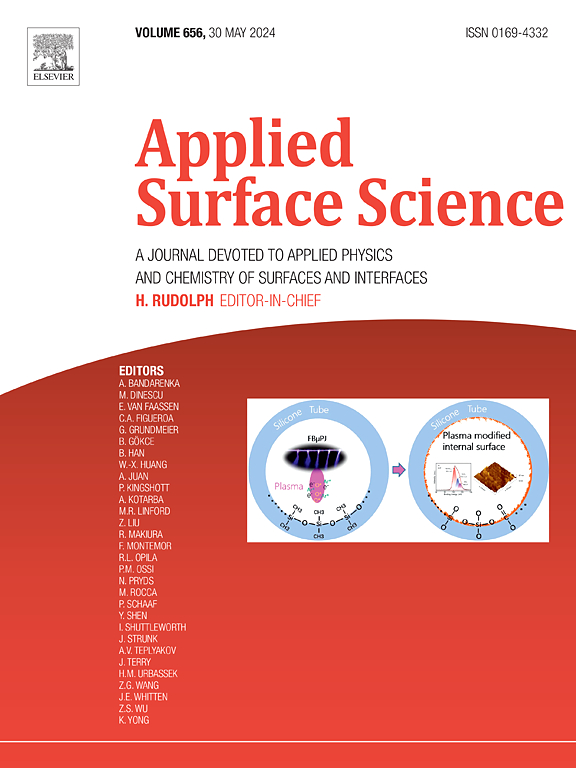Environmentally-friendly preparation nanometer Fe-Al solid solution alloy coatings on mild steel by electrodeposition in AlCl3-BMIC ionic liquid
IF 6.3
2区 材料科学
Q2 CHEMISTRY, PHYSICAL
引用次数: 0
Abstract
The formation of Fe-Al solid solutions can significantly enhance their corrosion resistance owing to the homogeneous microstructure. However, preparation high-iron-content alloys with solid solutions remains a considerable challenge. In this study, Fe-Al alloy solid solutions with high Fe content were successfully prepared via electrodeposition from an acidic 1-butyl-3-methylimidazolium chloroaluminate (AlCl3-BMIC) ionic liquid (IL) containing ferrous chloride (FeCl2). FeCl2 was dissolved in the acidic AlCl3-BMIC IL to form complex [Fe(AlCl4)4]2-, alongside the well-known [Al2Cl7]− species, facilitating the co-deposition of Fe-Al alloy. The electrodeposition process of Al-Fe alloys was observed to be a normal co-deposition, where the presence of Fe(II) inhibits the reduction of [Al2Cl7]−, resulting in Fe content consistently exceeding 50 at%. During electrodeposition, increasing temperature and decreasing current density resulted in higher Fe content in the Fe-Al alloy. By adjusting the current density and temperature, Fe-Al alloys with diverse microstructures, including microspheres, staghorn coral, and pagoda-like structures, were successfully fabricated. The resultant Fe-Al alloys with Fe content between 39.2 at% and 76.3 at%, exhibit solid solutions, and they evolves from a dual-phase mixture of Fe(Al) and Al(Fe) solid solutions to a single-phase Fe(Al) solid solution as the Fe is up to 76.3 at%. Notably, the alloy coatings containing 61.6 at% Fe, composed of polycrystalline particles with an average grain size of 10.75 nm, demonstrated superior anti-corrosion performance compared to pure Al coatings. The enhanced anti-corrosion properties of the Fe-Al alloy coatings on mild steel can be attributed to several factors: the absence of intermetallic compounds, the extended solubility of Fe and Al within the Al-based and Fe-based solid solutions, and the compact structure made of nanoparticles. Accordingly, the combination of electrodeposition techniques with solid-solution alloy offers a promising approach for effective chemical protection on iron-based material surfaces.


铁铝固溶体的形成可显著提高合金的耐腐蚀性,因为其具有均匀的微观结构。然而,用固溶体制备高含铁量合金仍然是一个相当大的挑战。在本研究中,通过从含有氯化亚铁(FeCl2)的酸性 1-丁基-3-甲基咪唑氯铝酸盐(AlCl3-BMIC)离子液体(IL)中电沉积,成功制备了高铁含量的铁铝合金固溶体。氯化亚铁溶解在酸性 AlCl3-BMIC 离子液体中,形成复合物[Fe(AlCl4)4]2-,与众所周知的[Al2Cl7]-物种一起,促进了铁铝合金的共沉积。据观察,铝铁合金的电沉积过程是一种正常的共沉积过程,Fe(II)的存在抑制了[Al2Cl7]-的还原,导致铁含量持续超过 50%。在电沉积过程中,升高温度和降低电流密度会使铁铝合金中的铁含量增加。通过调整电流密度和温度,成功制备出具有不同微观结构的铁铝合金,包括微球、鹿角珊瑚和宝塔状结构。铁含量在 39.2% 至 76.3% 之间的铁铝合金呈现固溶体,当铁含量达到 76.3% 时,它们从铁(铝)和铝(铁)的双相混合固溶体演变为单相铁(铝)固溶体。值得注意的是,含铁 61.6% 的合金涂层由平均晶粒尺寸为 10.75 nm 的多晶颗粒组成,与纯铝涂层相比,具有更优异的防腐蚀性能。低碳钢上的铁铝合金涂层之所以具有更强的防腐蚀性能,可归因于以下几个因素:不含金属间化合物、铁和铝在铝基和铁基固溶体中的溶解度较高、纳米颗粒结构紧凑。因此,电沉积技术与固溶体合金的结合为铁基材料表面的有效化学保护提供了一种可行的方法。
本文章由计算机程序翻译,如有差异,请以英文原文为准。
求助全文
约1分钟内获得全文
求助全文
来源期刊

Applied Surface Science
工程技术-材料科学:膜
CiteScore
12.50
自引率
7.50%
发文量
3393
审稿时长
67 days
期刊介绍:
Applied Surface Science covers topics contributing to a better understanding of surfaces, interfaces, nanostructures and their applications. The journal is concerned with scientific research on the atomic and molecular level of material properties determined with specific surface analytical techniques and/or computational methods, as well as the processing of such structures.
 求助内容:
求助内容: 应助结果提醒方式:
应助结果提醒方式:


